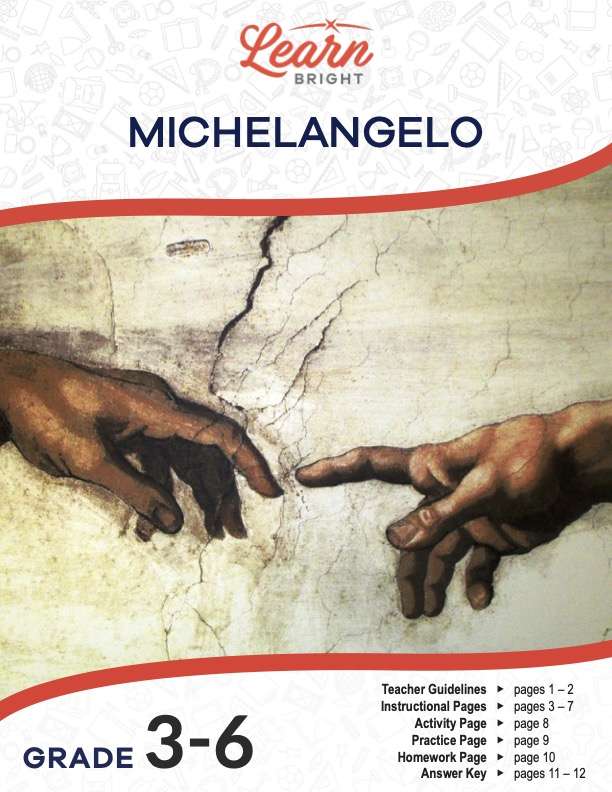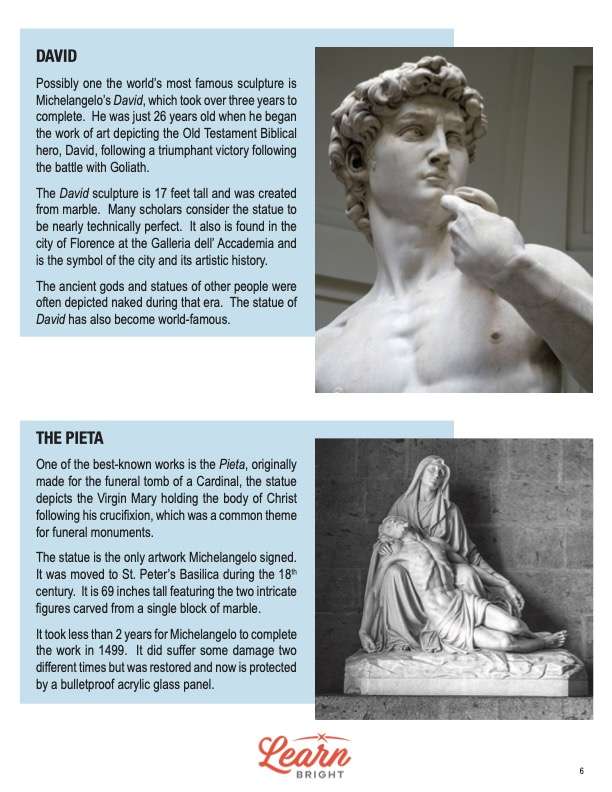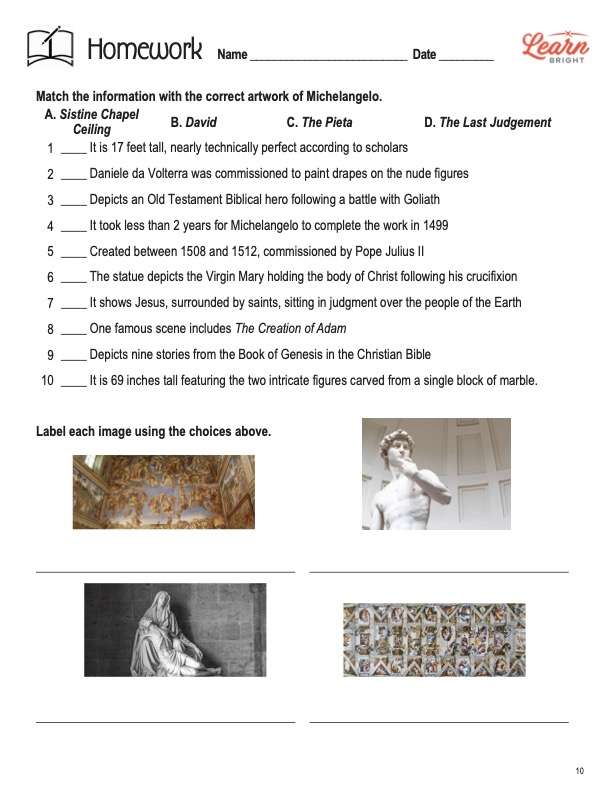Description
What our Michelangelo lesson plan includes
Lesson Objective and Overview: Michelangelo introduces students to the famous artist Michelangelo, his artwork, and his impact on the art world. A biography of Michelangelo is presented as part of the lesson, including his various apprenticeships and Christian artwork. Michelangelo’s most famous works are described with photographs, including the Sistine Chapel, David, and the Pieta. At the end of the lesson, students will be able to identify Michelangelo, list his accomplishments, and explain his impact on the art world. This lesson is for students in the 3rd grade, 4th grade, 5th grade, and 6th grade.
Classroom Procedure
Every lesson plan provides you with a classroom procedure page that outlines a step-by-step guide to follow. You do not have to follow the guide exactly. The guide helps you organize the lesson and details when to hand out worksheets. It also lists information in the orange box that you might find useful. You will find the lesson objectives, state standards, and number of class sessions the lesson should take to complete in this area. In addition, it describes the supplies you will need as well as what and how you need to prepare beforehand. The supplies you will need for this lesson are colored pencils or paints, construction paper, and the handouts.
Options for Lesson
Included with this lesson is an “Options for Lesson” section that lists a number of suggestions for activities to add to the lesson or substitutions for the ones already in the lesson. If you’d like to add to the lesson activity, you can have students copy two paintings instead of one. For an additional activity, you can have your students create an acrostic poem using the title of a painting that describes their feelings about the painting. For another activity, you can assign each student one of the paintings to research. If you’d like to expose students to more of Michelangelo’s work, you can use the additional resources for the lesson to show your students as many of his works as possible. Students can then choose one of the artworks and write an essay about how it makes them feel and what they think about when viewing it. Finally, you can conduct a class discussion about the controversy surrounding the nude figures which were later painted over to add clothing.
Teacher Notes
The teacher notes page includes a paragraph with additional guidelines and things to think about as you begin to plan your lesson. This page also includes lines that you can use to add your own notes as you’re preparing for this lesson.
MICHELANGELO LESSON PLAN CONTENT PAGES
Michelangelo
The Michelangelo lesson plan includes five content pages. We often call Michelangelo a “Renaissance Man,” because he was a painter, sculptor, architect, poet, and engineer. His full name was Michelangelo di Lodovico Buonarroti Simoni, but we just call him Michelangelo. During his lifetime, he created some of the most well-known works of art of all time.
Michelangelo, like his contemporary Leonardo da Vinci, lived during the Renaissance Period. This era began in about the year 1300 and went until about 1700. The word “renaissance” means “rebirth” in French. During this time, people wanted to learn about ancient times. We think of it as the start of the “modern age”. Many famous artists, writers, philosophers, and more lived during this time, and Michelangelo was one of the greatest.
Michelangelo lived a busy life and created some of the most famous artworks of all time, from statues to paintings. People know his name all over the world. We know a lot about him because of the art he created during his life and the journals, letters, and poems he left behind. They also published a biography about him during his lifetime.
Early Life
Michelangelo was born on March 6, 1475 in Caprese, Italy. His mother’s name was Francesca di Neri del Miniato di Siena and his father’s name was Lodovico di Leonardo di Buonarroti di Simoni. Michelangelo’s father worked for the government. His family moved to Florence shortly after he was born. He considered Florence his hometown.
Florence was the artistic center of the Renaissance and was therefore the perfect place for Michelangelo to develop his talents as an artist. He became interested in art at an early age. His mother died when he was 6, and his father did not initially approve of his interest in art.
His father sent him to live on a small farm with a stonecutter who he knew because he’d worked at a marble quarry owned by Michelangelo’s father. Here, Michelangelo learned how to use a chisel and hammer. He did not find normal school lessons interesting. Instead, he liked to explore the churches of the city and draw copies of the frescos, or paintings, found inside the churches. At 13 years old, he apprenticed with a muralist named Domenico Ghirlandaio.
Ghirlandaio was busy working for a powerful local family, the Medicis. They were patrons of the arts and funded an academy for painters, philosophers, and poets. Michelangelo became a student at the academy from 1490 to 1492, when he was just 15. The academy influenced his ideas and art.
Training and Commissions
Though he worked in many mediums, Michelangelo always primarily considered himself to be a sculptor. Once, he got into an argument with another sculptor at the academy. During this argument, the other student punched him and permanently disfigured his nose and changed his appearance for the rest of his life. During his time at the academy, he created a notable work called The Madonna of the Stairs. This was a relief, or a flat panel with raised figures. He also created other reliefs for his patron, Lorenzo de Medici.
His patron died in 1492, bringing lots of change to Michelangelo’s life. At this time, he moved back in to his father’s house. He asked the prior at the Church of Santo Spirito if he could study the anatomy of the bodies of people who died in the church hospital. He thanked the church by carving them a large wooden crucifix in 1493, which the church still displays today.
In 1494, Michelangelo started working for the Medici again. At this time, another prominent figure appeared in Florence. This man’s strong influence led people to burn books, get rid of their jewelry, and chase the wealthy people out of the city, including the Medici.
Michelangelo took this as an opportunity to travel. He stayed in Venice and Bologna. In Bologna, he began work on three figures for their marble Shrine of Saint Dominic. After things calmed down in Florence, he returned and started working for the Medici family again.
Continuing Career
In June 1496, at age 21, Michelangelo arrived in Rome, where he lived near the church of Santa Maria de Loreto. During this time, he received a very important commission from the local Cardinal, a leader of the church. He wanted Michelangelo to make a very large statue of Bacchus, the Ancient God of wine. However, when Michelangelo delivered the statue, the Cardinal was not happy with it, because the sculptor portrayed Bacchus as drunk and staggering. A local banker ended up purchasing the statue for his personal garden.
Next, a French Ambassador commissioned Michelangelo to create a statue of the Virgin Mary in mourning over the dead body of Jesus. The Italian word “Pieta” refers to Christian artwork, whether painting or statue. Michelangelo created a Pieta of Mary and Jesus, currently displayed at St. Peter’s Basilica in Rome. This is his most famous Pieta, and thousands of people from all over the world visit it every day. Throughout his life, Michelangelo created many different works of art. He also worked as an architect and wrote more than 300 poems, starting in 1530s. These poems dealt with philosophical themes and often spoke about how the human soul can reunite with God with enough love. He also wrote lyrical letters to family talking about his attachment to young men and desire for a father-son relationship. Michelangelo did not married and didn’t have children.
Michelangelo died in 1564, at age 88. He continued sculpting and painting until his death. In the 1540s, he started a pieta for his own tomb, but did not finish it. You can still see it not far from the site of his burial at the Basilica di Santa Croce in Florence.
Famous Works
We know Michelangelo as one of the most influential figures in art. To this day, more than 450 years after his death, he’s one of the most famous and celebrated artists of all time. He created more than 600 paintings and many sculptures. He has inspired many artists.
Sistine Chapel Ceiling
The Sistine Chapel Ceiling is the ceiling of the Sistine Chapel in Vatican City, located in Rome. Michelangelo created in from 1508 to 1512. Pope Julius II commissioned the work, which depicts nine stories from the Book of Genesis in the Bible. Michelangelo did not originally want to do the project, but it’s one of his most famous works of art today. Millions of people come to see it every year. One of the most famous scenes is the Creation of Adam.
David
One of the most famous sculptures in the world, Michelangelo’s David took him over three years to complete. He was 26 years old when he began this project, which depicts the Old Testament Biblical hero David after his victory against Goliath.
This sculpture is 17 feet tall and carved from marble. Scholars consider it a technically perfect work of art. You can see it in Florence at the Galleria dell’Accademia. It’s a symbol of the city and its artistic history.
In this time, artists frequently depicted many statues of ancient gods and other people naked. David, one of these statues, is now world famous.
The Pieta
Another of Michelangelo’s best-known works is the Pieta. He created this work originally for the funeral tomb of a Cardinal. The statues shows the Virgin Mary holding Christs’ body after his crucifixion. This was a common theme for funeral monuments at this time.
This is the only piece of artwork that Michelangelo ever signed. They moved it to St. Peter’s Basilica in the 18th century. It’s 69 inches tall and features two intricate figures carved out of one block of marble.
Michelangelo completed this work in less than two years. He finished it in 1499. It suffered damage on two occasions, but they restored it successfully both times. Today, you can find it behind a bulletproof acrylic glass panel.
The Last Judgement
25 years after completing the Sistine Chapel, Pope Clement VII called Michelangelo back to work on The Last Judgement, which he worked on from 1534 to 1541. At the center of this work is Jesus, surrounded by saints and sitting in judgement over Earth. Some people are shown being welcomed into heaven, while others are condemned to Hell.
These figures appear naked, which was a controversial decision. Michelangelo argued that they would not need clothes in heaven. After Michelangelo’s death, however, another artist named Daniele da Volterra painted drapes on the nude figures. For this work, he earned the nickname “the painter of pants”.
Michelangelo was a “Renaissance Man” who painted, sculpted, and more. We remember him today as an inspiration to young artists.
MICHELANGELO LESSON PLAN WORKSHEETS
The Michelangelo lesson plan includes three worksheets: an activity worksheet, a practice worksheet, and a homework assignment. You can refer to the guide on the classroom procedure page to determine when to hand out each worksheet.
PAINTING ACTIVITY WORKSHEET
For the activity worksheet, students will choose one of Michelangelo’s paintings to create a rough cope of. They will create a final copy using either colored pencils or paint. Finally, they will explain why they chose that painting.
MICHELANGELO PRACTICE WORKSHEET
The practice worksheet asks students to answer 15 questions about the lesson material and tell whether seven statements are true or false.
MATCHING HOMEWORK ASSIGNMENT
For the homework assignment, students will first match the information with the correct artwork of Michelangelo’s. They will also label a few images using the names of the works from the first section of the worksheet.
Worksheet Answer Keys
This lesson plan includes answer keys for the practice worksheet and the homework assignment. If you choose to administer the lesson pages to your students via PDF, you will need to save a new file that omits these pages. Otherwise, you can simply print out the applicable pages and keep these as reference for yourself when grading assignments.









